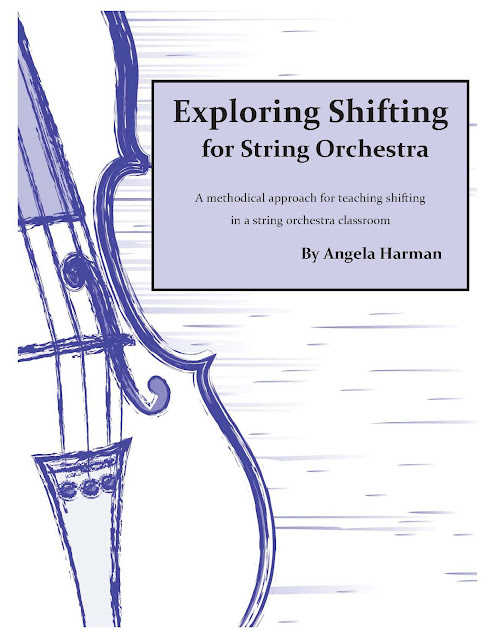It's finally finished - my book for teaching shifting in string orchestra! I started working on this last year because I HATED teaching shifting in my orchestra class. The method books I used had shifting exercises for my 2nd year players, but I found that my students would get frustrated trying to play those pages because they weren't ready. Students need time to internalize the motions for shifting and they needed simple exercises to help them learn to read notes in a new position.
I haven't been able to depend on standard method books for teaching shifting because the exercises in those books move too quickly. They contain tricky rhythms which draw student focus away from the task at hand...shifting! I found myself skipping sections about shifting and feeling guilty that my students were not proficient in that area.
My frustrations with teaching shifting changed last year when I started using many of the exercises in this book with my 2nd year students. I also switched method books...I now use String Explorer book 1 for my beginners because that book takes students further in technique than any other book. For my 2nd year players, I use String Basics book 2. It's not very hard...we get through the book in about 1/2 a year. Students get really good at playing flats and extensions - which is my goal for them during their 2nd year. Then we have time to take a break from our method book and focus on shifting for a term. I didn't spend tons of time each day....maybe 5-10 minutes. It didn't take long for my students to play in 3rd position with great intonation. My 3rd year students are using String Basics book 3 -which contains a lot of 3rd position. After using the exercises in 'Exploring Shifting for String Orchestra,' I feel my students will now be well-prepared to easily master the shifting regimen in book 3.
Here's my favorite part about teaching shifting to my 2nd year players.....it helps the students stay super motivated! I purchased a couple of pieces for them to play that had some shifting: 'American Princess' by Bob Phillips and 'Impact' by Bob Phillips. Both pieces are gorgeous and I played the audio for my students so they would really want to learn the music. My class fell in love with both pieces and they were willing to work hard to master them to sound amazing. The great thing about those pieces is that every section of the orchestra gets to shift and the melodies and harmonies are fun to play in position! I even got out a cello and learned the cello part myself because the music is so beautiful.
Thanks to the shifting work we had done, my students excelled at learning our concert music. It was a lot of work..don't get me wrong....but they were able to do it with great intonation and musical phrasing. When we performed, I was in tears, the audience was in tears, and students felt such a sense of accomplishment. It is now one of my happiest performance memories and I'm so proud of my students....and it all started with a willingness to teach shifting in a way that all students could achieve success.
My book contains a 50 page teacher manual with tips for teaching shifting and 18 page student books for violin, viola, cello and bass (123 pages total). I am not selling a hard printed copy of this book. You can purchase a PDF downloadable version HERE or HERE. The beauty of a printable book is that you can print as many as you need for your entire class at a very low price. You can also pick and choose which pages to do if you don't want to use the entire book. It is a lot cheaper to print your own shifting workbook than to buy a hard copy of a book for every student. Also if you find any errors, feel free to email me and I will fix it and re-send the file.
I'm the first to admit that I'm not a bass player. Bass shifting can get pretty crazy. I have some really smart bass students in my class who enjoyed figuring out higher positions. For my bass players that are slower learners, I allowed them to change fingerings and play more in 1st position. As a teacher, you can change/adjust fingerings as needed depending on student ability levels.
Read the preface for more info about the book and a sample of the first couple pages below:





No comments:
Post a Comment